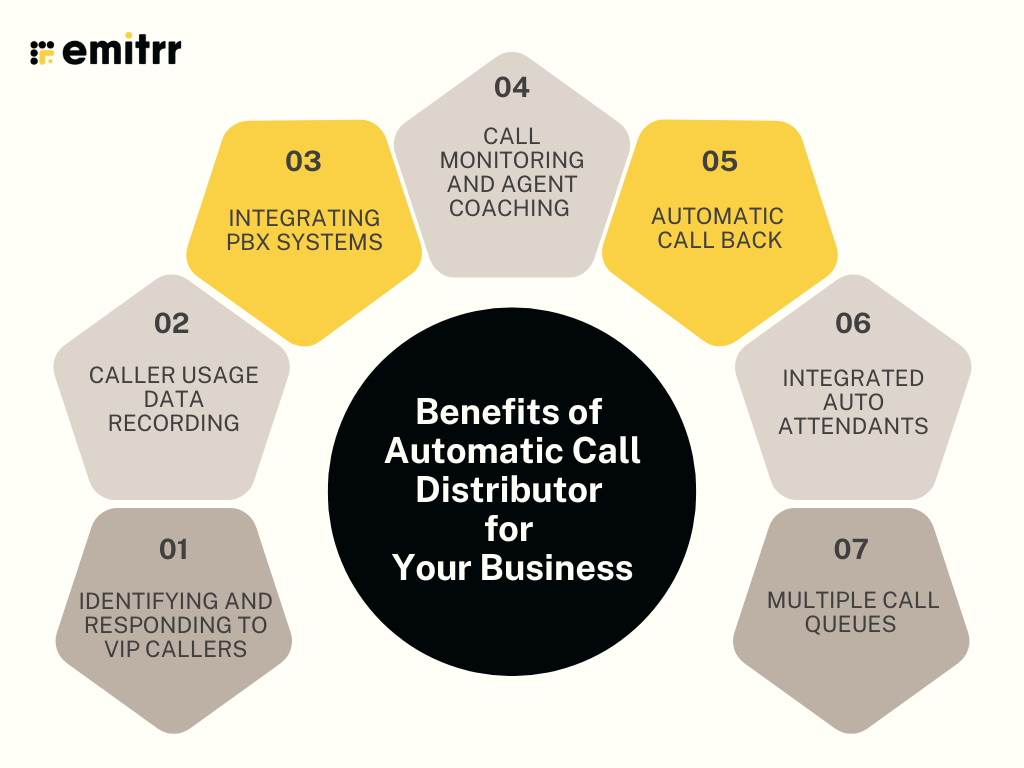Introduction
Have you ever wondered how your call gets connected to the right person when you contact a call center? That smooth transfer isn’t a coincidence, but it is the work of something called an Automatic Call Distributor (ACD).

In simple terms, an ACD is a system that ensures every incoming call is routed to the most suitable agent or department. In this blog, we will break down what Automatic Call Distribution means, how it works, and why it is a critical component in any efficient call center setup.
What is an Automatic Call Distributor?
If you are in the call center business, ACD is a term you must have familiarized yourself with. It is, after all, the backbone of any call center and is one of the call center terminologies that reign supreme.
So, what is ACD? ACD stands for Automatic Call Distributor, and its job is to route calls to agents or departments.
Since the number of calls received in a call center is quite high, making sure that calls reach the most appropriate agent is of the utmost importance. An instrument that can facilitate this task is the ACD. ACD, in conjunction with other tools such as IVR and CTI, helps accomplish this task.

How Does an Automatic Call Distributor Work?
Automatic call distribution systems, otherwise known as call routing systems, direct incoming calls to the appropriate representatives based on your business’s preferences and needs. ACDs work to close the gap between customer expectations and business resources.
The basic idea behind good customer service is simple: when a customer needs help, answer the phone and resolve their issue. But it isn’t always this easy. Customers don’t often stick to normal business hours or have much sympathy for call centers flooded with a high volume of calls.
That’s why more and more call centers are relying on ACDs to enable a smooth, efficient process by connecting the right caller with the right agent as quickly as possible.

So, how exactly does the ACD route calls?
Calls are routed based on certain criteria
- If the call is for a specific department, for example, sales or tech.
- If the call is to be routed according to agents based on their skill, knowledge, and expertise. With a skills-based routing system, a company could automatically route calls to the right product specialist.
- If the call is to be routed according to the time of the day. For example, companies with offices nationwide might route callers to an office on the East Coast during hours when West Coast offices aren’t open.
- If the call is to be routed in a round-robin fashion. Round-robin algorithms work to give each rep an equal share of incoming leads. Round-robin routing algorithms are often a function of automatic call distributors.
- If the customer has dialed a specific phone number
- If the customer has requested a specific parameter on the IVR
So, what is ACD, and how does it turn a flood of incoming calls into an organized queue? An automatic call distributor system directs incoming calls to the most qualified agents. How that’s determined is based on the distribution method you choose.
ACD distribution methods
Linear Call Distribution—Calls are distributed in order, starting at the beginning each time. This may be based on a list or a predefined configuration. In each order, it starts with the same agent.
Circular Call Distribution—Calls are distributed in order, starting with the next in order. The agent who is after the last agent to receive a call is the one who’s first in line.
Uniform Call Distribution—Calls are distributed uniformly, starting with the person who has handled the fewest calls. It starts with the agent who has been idle for the longest period.
Simultaneous Call Distribution—Calls are available to all agents to attend. The agent who picks up the call first gets to attend to it.
Weighted Call Distribution—calls are routed to available agents according to configurable weighting, such as differing skill sets within customer service representatives.
As discussed in detail above, the call routing algorithm for ACD can work in a few different ways. To direct calls appropriately, ACD systems can be configured to consider the incoming phone number, traffic volume, call queue wait times, time of day, and the skills or departments needed on the receiving end of a call. When callers indicate their issue, the ACD groups them according to the best department or agent to resolve the problem at hand. So ACD distribution and call routing go hand in hand.

ACD AND IVR
An automatic call distribution system has some advanced features that make it more advanced than an IVR. An IVR is usually part of an Automatic Call Distributor system.
An IVR is a keypress-triggered response system that renders information to callers without the assistance of an operator, usually for instant information retrieval, while an ACD is a programmed call routing system that routes incoming calls to skill-based agents, teams, or menus based on rules like area code of telephone number, time of the day, etc.
ACD AND CTI
ACDs are implemented along with CTI (Computer Telephony Integration). CTI, or Computer Telephony Integration, is quite crucial in a call center. CTI helps one coordinate and manage phone calls on computer systems. Agents are able to use advanced phone controls from their computers. Such controls could include transferring calls or putting them on hold, muting, etc.
CTI and ACD work together to help divert calls to appropriate agents/departments and allow them to handle their calls over computer systems.
ACD QUEUE
The ACD queue distributes calls to specific groups of terminals that the agents use. ACD queues offer additional functionality for businesses with high call volume or for those that regularly have multiple calls come in at the same time or within a few minutes of each other. This allows agents to handle calls one at a time. Callers are placed in a line or a queue. Calls are distributed in a first-in, first-out method. As and when the agents become available, the callers are removed according to their position in the queue, and their call is attended to.
Benefits of Automatic Call Distributor for Your Business
What an ACD can essentially do for your business is make handling calls simpler and more effective. It helps streamline your incoming calls. Apart from allowing for skill-based routing and its valuable integration with CTI, ACD also has a number of other benefits.

IDENTIFYING AND RESPONDING TO VIP CALLERS
ACDs have the feature of identifying VIP customers through predetermined information. These VIP callers are then assigned the most appropriate agent as quickly as possible. If the appropriate agents are occupied at that time, then the VIP callers are placed at the front of the queue
CALLER USAGE DATA RECORDING
The information related to the customer’s call can be acquired. This data can include the number of incoming calls, the amount of time an agent spends on the phone with a caller, the total number of calls (incoming and outgoing), the length of calls, the waiting time before the call was answered, etc.
INTEGRATING PBX SYSTEMS
Companies that use PBX systems from different carriers can use an ACD to operate as one cohesive call center.
CALL MONITORING AND AGENT COACHING
ACDs allow call center managers to engage in call monitoring, call conferencing, call barging, and whisper coaching. With this feature, managers can coach call center agents and improve future calls.
AUTOMATIC CALL BACK
Customers who do not wish to wait in line can have the option of requesting a callback.
INTEGRATED AUTO ATTENDANTS
For callers who would like to speak to a specific agent, they can dial their extension to be immediately transferred
MULTIPLE CALL QUEUES
ACD allows for multiple call queues according to different departments, different teams of agents, or different numbers that the caller dialed. This helps streamline calls and increase efficiency.

How Emitrr Helps with Automatic Call Distribution
Emitrr enhances traditional Automatic Call Distribution by offering intelligent call routing that ensures every caller is connected to the most suitable agent or department. Whether it’s routing based on availability, agent skill set, or call priority, Emitrr makes sure no call is left hanging. Its smart integration with tools like IVR calling and CTI creates a seamless experience for both businesses and customers, reducing wait times and improving overall service efficiency.
This AI call center software is especially valuable as a VoIP for small businesses. With flexible, cloud-based infrastructure, it provides an affordable and scalable ACD solution without the need for complex hardware. This means that even growing teams can manage high call volumes seamlessly.
Emitrr helps you bring it all together by automating calls, improving agent productivity, and keeping customers satisfied.
Watch this video to learn everything you need to know about VoIP phone systems and how they can transform your business communication:
FAQs
The purpose of automatic call distribution is to manage incoming calls more effectively. This system helps reduce call hold times, simplifies the communication process, and routes the caller to the most appropriate agent for better resolution.
ACD automatically distributes calls or routes calls based on different criteria. Whereas, IVR is an automated menu that allows the caller to navigate through different options to help them reach the most relevant person for their query.
IVR mishaps can lead the customer to abandon the call or, even worse, to revenue loss. If your IVR system does not work properly and is inefficient, then your operational cost can rise due to the added agent burden.
Conclusion
Automatic Call Distribution offers more than a call routing tool; it forms the foundation of an efficient, customer-friendly support system. By ensuring that every call is directed to the right agent at the right time, ACD helps businesses save time, reduce frustration, and deliver better service. When combined with modern solutions like Emitrr, ACD becomes even more powerful, bringing automation, flexibility, and intelligence into your call center operations.
Schedule a demo with Emitrr and experience smarter call handling today.

 4.9 (400+
reviews)
4.9 (400+
reviews)
